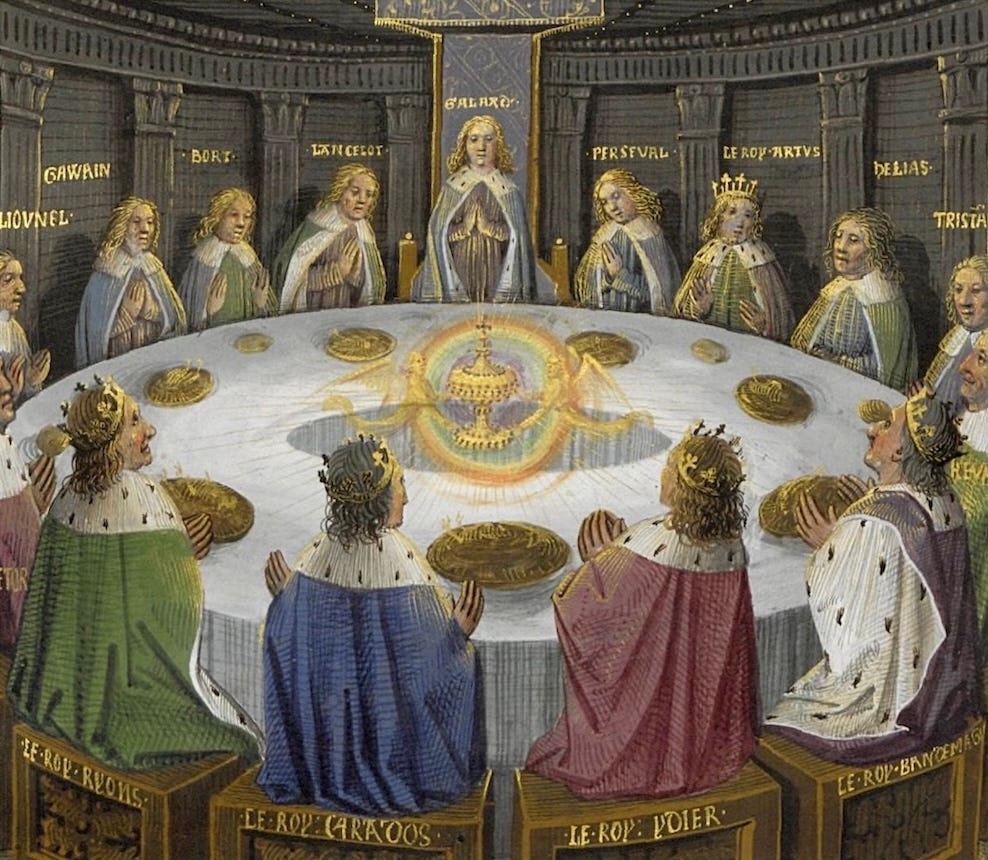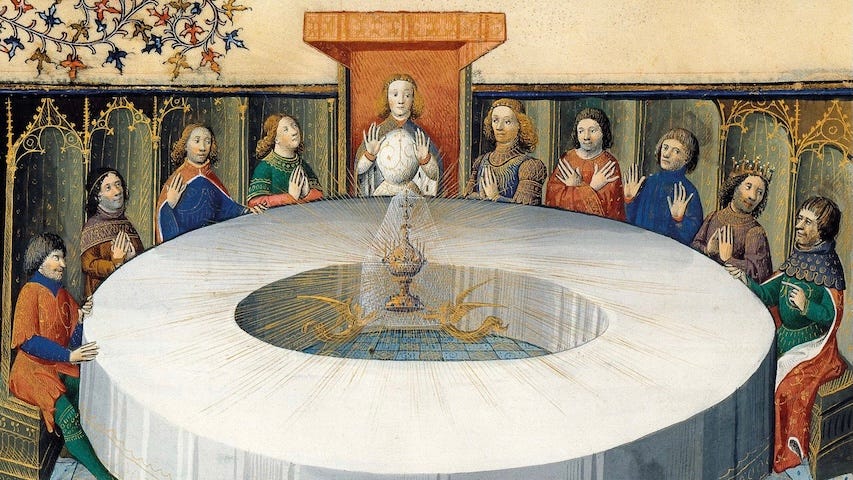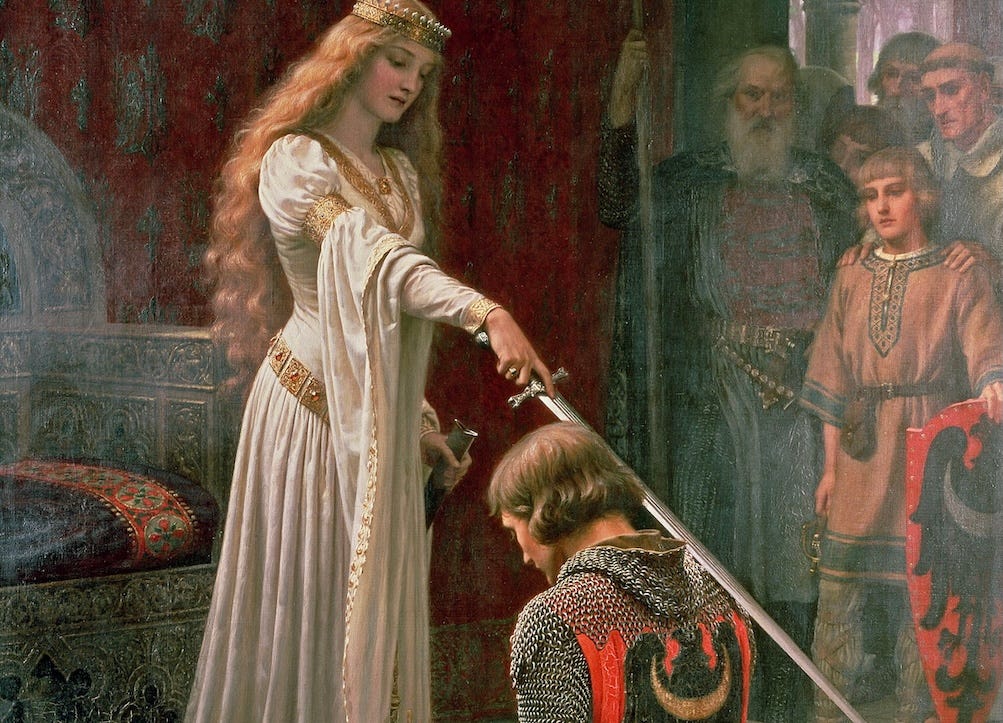The Truth About the Holy Grail
And the road to transformation...
“Be of good cheer,” Lancelot said to him. “Take comfort from the fact that we go on a great and noble cause. All men must die, sire, but we will die in glory.”
-Sir Lancelot to King Arthur, Le Mort d’Arthur
The Holy Grail has long held a special place in the Western imagination: from Chrétien de Troye’s medieval romances to Monty Python and the Holy Grail, the quest for the Grail has been viewed with both reverent awe, and a hefty dose of disbelief.
What are we to make of a story so fantastical that it has transcended itself, both in myth and in caricature?
Of course, the quest to find the elusive Grail has frustrated investigators since the time of Christ, and the many competing claims and unsuccessful searches for its whereabouts have led most to believe it’ll never be found — if they ever believed it to be real in the first place.
But those searching for a physical drinking vessel are missing the point. Fortunately, Thomas Malory’s 15th-century Le Morte d'Arthur contains the answer to understanding the Holy Grail.
This triumphant compilation of Arthurian legends spends extensive time documenting two knights’ respective quests for the Grail — and, in doing so, outlines what it’s really about: the path of spiritual ascent to Heaven.
Today, we explore what the quest for the Holy Grail as narrated in Le Morte d’Arthur can teach you about spiritual transformation. Because although the Grail seems always just out of reach, it is your choice to pursue it that changes everything…
Reminder: this is a teaser of our members-only deep dives.
To support our mission and get our premium content every week, upgrade for a few dollars per month. You’ll get:
Full-length, deep-dive articles every weekend
The entire archive of great literature, art, and philosophy breakdowns
Members-only podcasts and exclusive interviews
“Blessed Are Those Who Hunger”
The Knights of the Round Table are dining at King Arthur’s castle when they first glimpse the Holy Grail:
As they sat in their places, they heard a great murmuring in the air and the breaking of thunder, with a crash so loud that it seemed the palace might collapse. In the middle of the blast there came a sunbeam, seven times brighter than the light of day, and the company were lit with the grace of the Holy Ghost. They looked upon one another in wonder, because they seemed fairer and more radiant than they ever did before. They were unable to speak. They gazed, and were silent.
Then the Holy Grail was carried into the hall, covered in a cloth of white samite, yet none could see who held it. The hall itself was filled with the odor of sweet spices, and before each knight appeared whatever food and drink he most wished for. When the Holy Grail had gone through the hall, it vanished, as suddenly as it had appeared, in a cloud of light.
Even though the Grail has just provided each knight with “whatever food and drink he most wished for,” the men aren’t satisfied — because now a spiritual hunger has been ignited inside them. As a result, no fewer than 150 knights vow to embark on a quest for the Holy Grail, gravely troubling King Arthur:
“Many will die on their quest of the Grail. We will never be together again. Why should I not grieve?”
-King Arthur to Sir Gawain
This is where you begin to get an idea of what it means to pursue the Holy Grail. The Grail is the part of the divine that calls you in such a way that you can’t help but respond. Even if you are “full” — with literal food, but also wealth, recognition, etc. — it awakes in you a deeper desire for the eternal. This desire, in turns, drives you to leave all else behind.
In an attempt to console the dismayed King Arthur, Sir Lancelot offers him the following: “All men must die, sire, but we will die in glory.” It is a recognition, among other things, of the value of questing after the eternal — because the “great and noble cause” of your striving after it is enough to ensure you end in glory…
The Quest Begins
As the knights prepare to embark on their quest, some wish to bring their lovers with them. But before they can do so, a hermit enters the great hall to issue a warning:
“Fair lords,” he said, “who have sworn to pursue the Holy Grail, hear this. You must take no female with you on your quest. I warn you plainly that he who does not forsake all sin will not be permitted to see the mysteries of Our Lord Jesus Christ.” This was the reason why the knights left alone.
-Malory, Le Morte d’Arthur
The quest for the divine, in other words, is a solo journey — at least in the beginning. As we’ll see, characters get help from others along the way, and this plays a major role in each of their quests. But at the root of every spiritual journey there must be the confidence and resolve to go it alone.
As the knights then embark on their quests, they face many trials and tribulations. All of these, however, have a purgative quality to them: they work to reveal and strip away sin. And nowhere is this more evident than in the quest of Sir Lancelot.
Considered the greatest of King Arthur’s knights, Lancelot was the chivalric hero par excellence. But at the same time, he maintained a 24-year-long affair with King Arthur’s wife, Queen Guinevere. His quest for the Grail, therefore, forces him to come face-to-face with his sins — pride and adultery in particular.
One day, he rides into a “wild wood where there was no true path.” There he lies down and has a vision in which he gets robbed, but is “so overburdened with sin that he had no power to rise.” Immediately afterwards he journeys to a hermitage and begs the man living there to hear his confession.
The hermit obliges, and offers him the following advice:
“You ought to thank God, Sir Lancelot. You have been given great gifts. Of all knights you were the most beautiful. You were strong, and brave, beyond measure. But you have also committed great sins. That is why you sleep in the presence of Our Saviour, and why you are banished from the grace of the Holy Grail. If God is against you, your strength and courage count for nothing.”
The holy man then tells Lancelot that he “must forswear [Guinevere] for ever, as much as it lies within your power to do so.” Lancelot agrees to this, for he has finally come to the realization that:
“When I rode out for worldly deeds I was always the victor. No one could defeat me. But now that I’m on a sacred quest, I find that my sins hold me down…”
As Lancelot leaves the hermit’s house the next day, he passes a small chapel where an old man dressed in white smiles and greets him: “God, keep you safe, sir, and make you a good knight.” In other words, for as great a hero as the invincible Lancelot was, it was only after owning up to his mistakes that he truly began his journey as a knight.
But although Lancelot’s sins are now forgiven, their repercussions will continue to haunt him. It’s a poignant reminder that while repentance is important, the mistakes of your past might still impact your life in the present.
How is it, then, that Lancelot finally comes to see the Grail? And what is the help you need along the way in order to do so?
The answer to it all is found in Lancelot’s bastard son, a forgotten child who becomes the greatest knight of all, and reveals the key to completing the quest.
And what’s revealed is surprising indeed — because most people’s idea of how to get into Heaven is entirely wrong…
Keep reading with a 7-day free trial
Subscribe to The Culturist to keep reading this post and get 7 days of free access to the full post archives.







